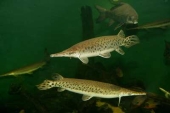Warning - unsolicited advice coming! Beth, I *really* recommend you follow this link:
https://www.vet.cornell.edu/animal-health-diagnostic-center/programs/avian-health/hatching-duck-eggs
Read it, copy it onto your computer and highlight in whatever colour is pleasing to you, the critical parts of each instruction.
Then I'd start a spreadsheet and write down the dates you need to do stuff. The turning 4 times/day is *really* important but you need to do so gently. You do
not want to screw up like I did and put an egg accidentally air sack down - sorry pre-duckling! Knowing when to
stop turning (sometimes called "lock-down") is equally important.
Consistent temperature is also important - some people are really anal about that and check it for a week with no eggs and 4 different thermometers, but I settled for putting the incubator in a small, central room in the house (a bathroom with no outside walls) and set it's baseboard heater for about 20C to decrease day/night temperature swings. 1.7C too low would definitely have been a problem.
Humidity is also a problem. I did OK last Aug. but this year no matter what I do the humidity keeps fluctuating. I'm aiming for the 55% relative humidity, and am accepting between 55% and 60% and checking approximately 4 times a day. Too much humidity and you can "drown" the ducks, not enough and they may not hatch.
There's no point candling until day 6 for Mallard domestics and 8-9 days for Muscovy. Try to only candle every 4-5 days. I sort by "sure they're good on day 6" to "hmmm... I'm not sure" so I only candle the not so sure ones the extra times. A real mom will leave the nest for food and water, so occasional cooling is actually considered by some people a good thing. I do think the audio clip I made of adult ducks "chatting" which I started playing for the eggs a week before hatch isn't a bad idea - I wanted them to know they were ducks.
I did fairly well last Aug, but I have to admit that this year it seems like we've got some problem that I can't pin down. I'm waiting to see how Messy Mom does with the 8 Khaki eggs under her (she's an experienced Muscovy Mom) that started in the incubator as a fertility test and I tucked them under her when something went wrong with her hatch (I think our oldest Muscovy male has lost fertility - no way to separate birds to test that - too many variables - sigh...)
It sounds like you've got some good ideas of what you need to do to improve your chances. I don't recognize the "turner" you mentioned, but I'm using one that holds the eggs vertically and tilts them back and forth and it seems to do the job. Sideways would seem more natural, but the incubator belongs to a friend and the deal was if I stored her stuff, I got to use it! Good luck and keep us posted. You can see some of this spring's eggs of mine on the 2020 hatch-a-long thread.









 2
2




 2
2





 2
2




 4
4




 3
3




![Filename: 20200706_101329.jpg
Description: [Thumbnail for 20200706_101329.jpg]](/t/141285/a/111800/20200706_101329.jpg)







